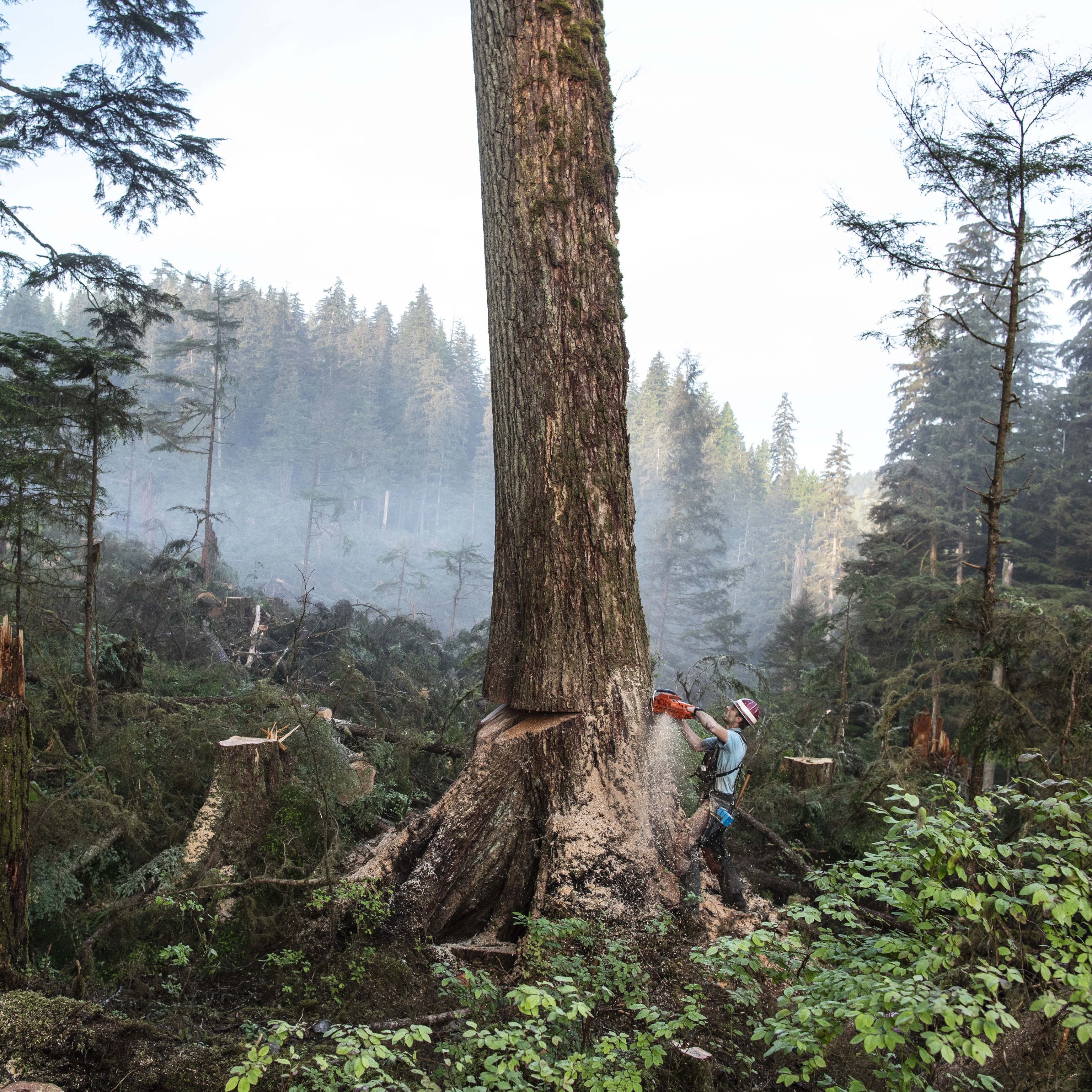
The Battle to Be King of the Lumberjacks
At U.S. logging championships, woodsy traditions meet modern-day hype—and the machismo is covered in sawdust.
In a backstage dressing room, giant, bearded, thick-necked men are getting ready to compete. The air reeks of body odor and ethanol fuel. One burly man gently thumbs his ax to check for any dull spots on the edge. Another sucks on a wad of tobacco chew before spitting the juice into a cup. A father and son tighten the bolts on a souped-up, ultradestructive chain saw outfitted with a 55-horsepower motor from a dirt bike.
It is like a prelude to a scene in a backwoods horror film: testosterone-charged brutes preparing for whatever menace might cross them. But within minutes, the showman in them is evident. They each grab a weapon of choice and head into the bright lights of an arena with 4,000 cheering fans, television cameras, and the vibe of an entertaining spectacle.
Once a year, these rugged men who can look something like mercenaries compete with tools that can sound something like race cars for the U.S. championship in lumberjacking.
This fringe sport began, so the legend goes, in Tasmania in 1870 as a bet between two loggers over who could fell a tree faster. During the next century, logging communities in Australia, New Zealand, Western Europe, and the United States held regional tournaments and expanded the competition into a variety of chopping and sawing events.
In 1985, Stihl, the Germany-based maker of chain saws and other tools, began sponsoring a series of contests in the United States to determine "the world's best lumberjack." The events in the United States now are broadcast on ESPN, have fans worldwide, and are known as the Stihl Timbersports Series United States lumberjack championships.
"As we like to say, the original extreme sport was born," said Roger Phelps, Stihl's head of promotions.
Over a weekend in June inside the Norfolk Scope Arena in Virginia, 16 professional lumberjacks chopped and sawed through pine logs quickly and accurately in front of a boisterous crowd.
"It's the greatest thing I've ever seen!" squealed one fan, Veronica Shifflett, at the sight of a chain saw shredding pine and spraying sawdust into the air.
"I didn't think a power tool could be a sport," said Rembert Johnson, who said he had arrived at the arena not knowing anything about lumberjacking contests.
The competition, which involves six events (known as disciplines), is rooted in the densely wooded regions of America and began long before chain saws were common. Most of the competitors are second- or third-generation professional loggers from the Pacific Northwest or Appalachia. Many grew up in the sport together, giving the circuit a fraternal feel.
Matt Slingerland, 23, from Rockwell, North Carolina, said he was so eager to follow in his father, Mike's, footsteps that in high school, Matt took online college courses so that he could turn pro on the lumberjack circuit at 19. Jason Lentz, 28, is a fourth-generation competitor.
"It means sawdust runs through my veins," he said.
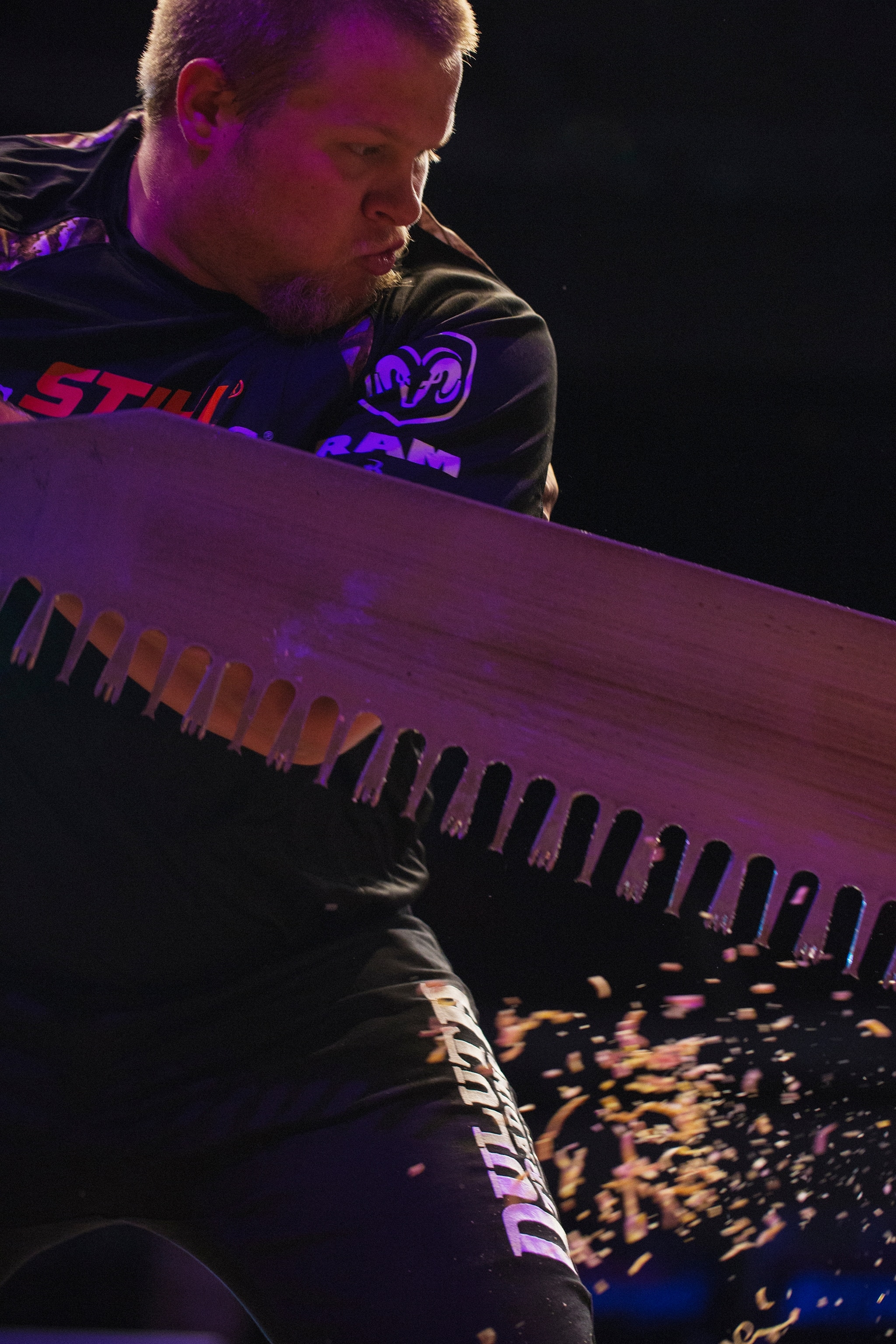
Beyond the frivolity of the televised event in Norfolk—at one point, hernia belts were given away to the loudest fans—the blue-collar ethos of the competition makes it particularly appealing to many.
"We use actual tools," lumberjack Branden Sirguy, 39, a forester in Washington State, pointed out. "We're pretty spoiled in this country. I think for my children to see how things were done before we had mechanization, we will have greater appreciation for ... the things we have."
The lumberjacks are proud of where they come from and the hours they spend on their craft. They typically do not say much, even when prompted. During the competition, when their muscles strain and adrenaline drives those critical final ax strokes, the most demonstrative many of them get is to raise a celebratory clenched fist. They do lighten up in one respect: "There are a lot of awkward wood jokes," said television commentator Adrian Flygt, who also competes and teaches high school physics in Colorado. "You got good wood today?"
That's not just a joke. A comparatively dense log, known as a bone, could ruin a lumberjack's chances in a competition if it is particularly difficult to cut.
For every event, a specific log is assigned to each competitor, who inspects it, rotating it to find the softest point of entry, likely the side of the tree that was exposed to the least wind. Lumberjacks bring a dozen axes to competitions to cater to various types of wood.
"It's like a very lethal golf bag," Phelps said.
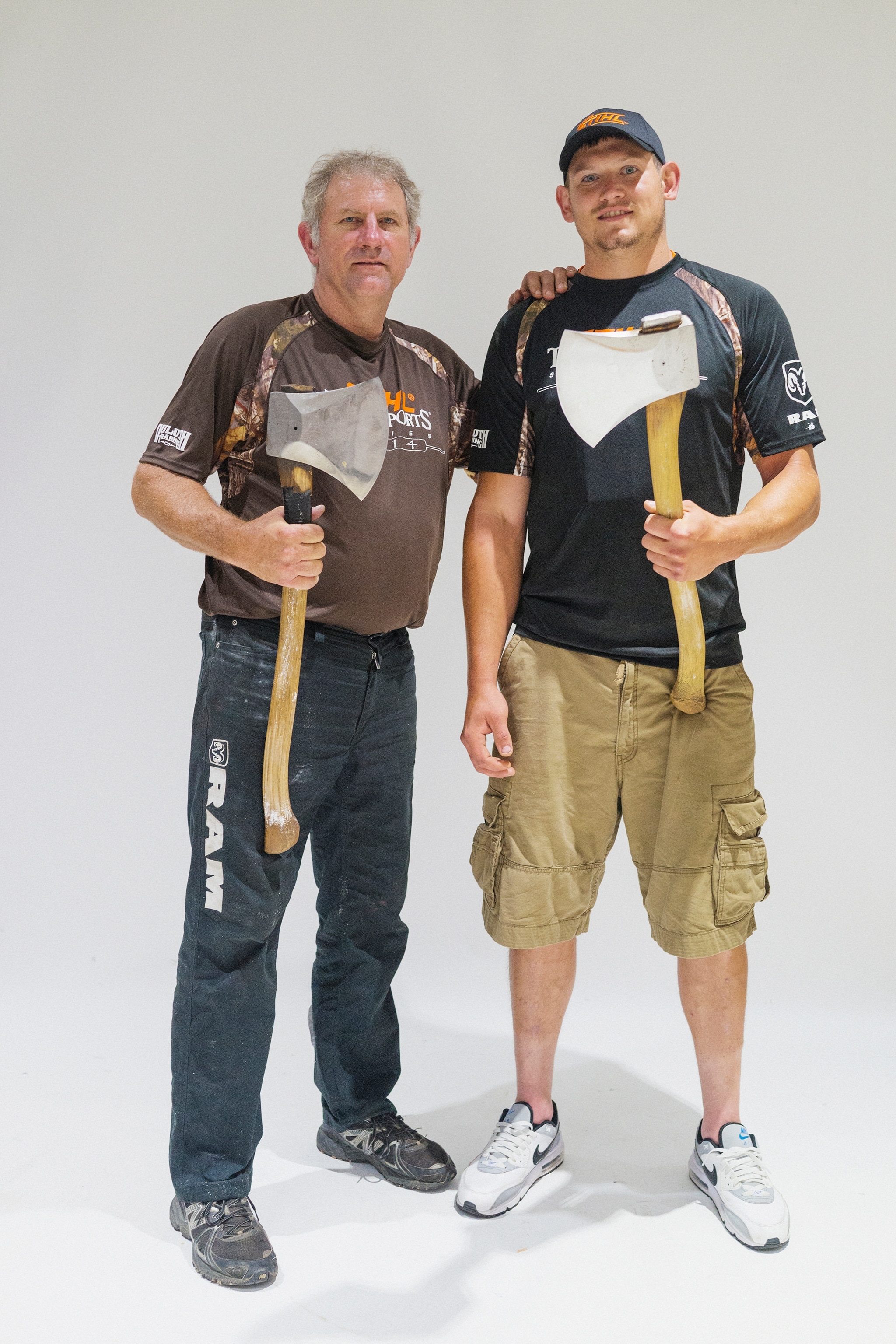
Experience Matters Most
Physical strength is apparent in the prototypical build of a Timbersports star: broad shoulders, meaty hands, massive forearms, trunklike thighs, and a gut. But as much as in any athletic competition, success is rooted in experience.
Most of the lumberjacks in the sport are older than 40. At 55, Melvin Lentz is considered the greatest axman ever. Lentz, of Diana, West Virginia, is a sturdy six feet four inches tall, weighs 245 pounds, and has a wide nose and a protruding chin that gives him something of a George Washington look. Lentz guesses he has won "at least a thousand" contests and six or seven world championships over international competition.
"I've been in the sport for so long—heck, I've lost count," he said.
It has taken several timber-felling-related injuries to slow Lentz down. While he was working his day job as a lumberjack in 1997, a steel prong of a knuckleboom crane used for lifting timber impaled his left leg. He required seven surgeries, could not walk for a year, and lost four inches of his femur, resulting in a hitch in his gait today. The next year, a piece of timber fell on him and broke his right leg. Most recently, he broke his left ankle, fibula, and tibia when he slipped and was struck by a falling log.
Despite the damage, Lentz won the lumberjack competition series in 2010 and arrived in Norfolk this year as one of the favorites to win.
"If I hadn't broken my legs and stuff, I think the Cogars would have their hands full," Lenz said.
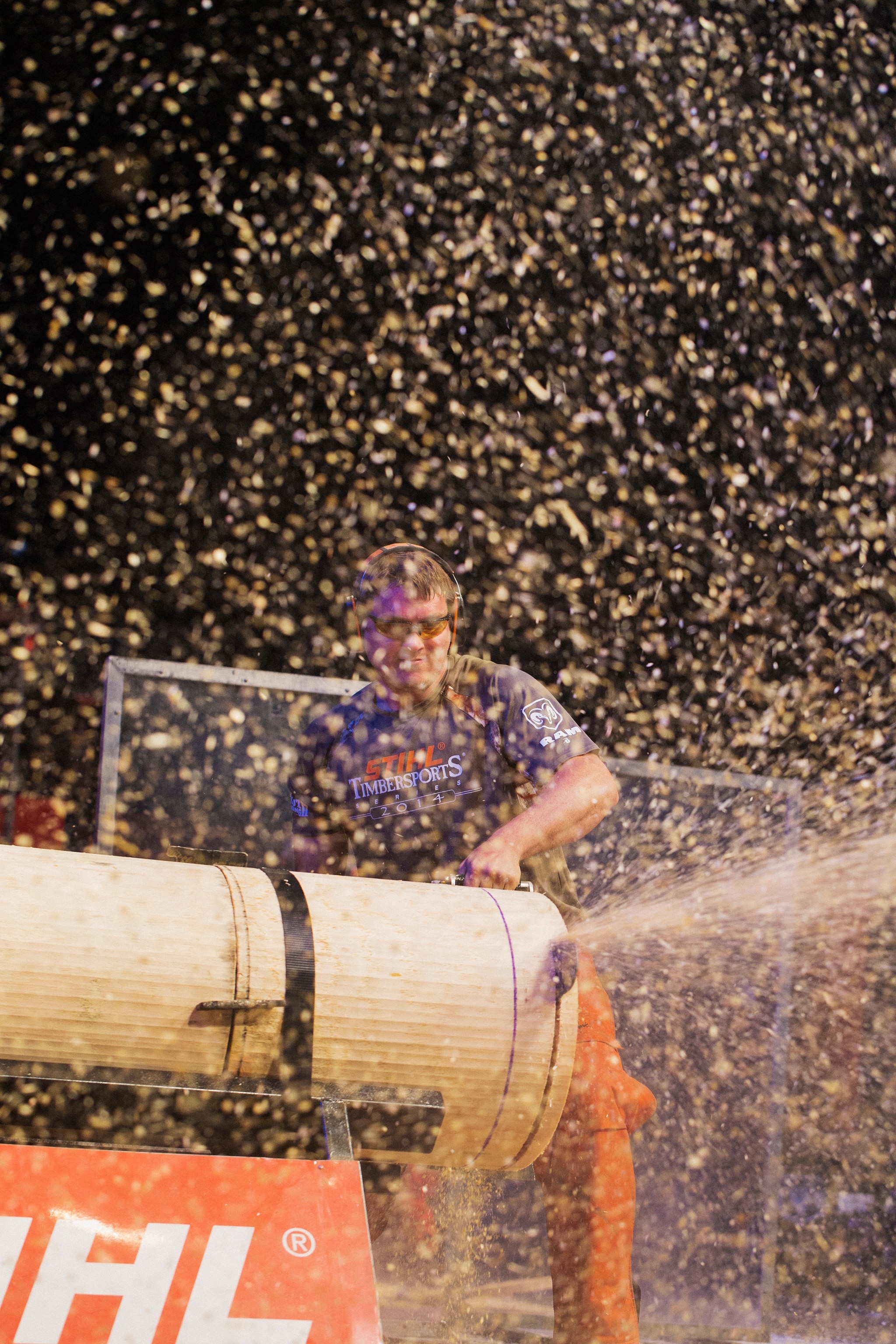
A Lumberjacking Dynasty
The Cogars would be cousins Arden and Matt Cogar.
Arden, 44, won four of five U.S. titles from 2008 to 2012, while Matt, 27, won in 2013. Based in the logging community of Webster Springs, West Virginia, the Cogars are a dynasty in lumberjack competitions: Nearly 30 family members have competed at one time or another, dating to the 1930s.
"There's bound to be somebody whose first date was throwing an ax," Scooter Cogar, an up-and-comer on the circuit, said of how women are indoctrinated into the family tradition. Instead of playing backyard football on Thanksgiving Day, the Cogars throw axes.
Loquacious, self-deprecating, and a civil defense trial lawyer by day, Arden stands out in the sport for his self-described quirky personality. "I'm overeducated," he said jokingly. "I don't know where I got that gene, because there's lots of people in my family that don't have it."
His physical appearance is similarly unconventional among competitive lumberjacks. With his thick-rimmed glasses, Australian cattleman's hat, goatee, and shaved head, he acknowledges looking like a rotund, lumberjack version of Walter White's alter ego, Heisenberg, from the television series Breaking Bad. He has competed in the lumberjack series for 27 years. His daily training program includes meditation and weight lifting.
More soft-spoken, less poetic, and clean-shaven compared with his cousin, Matt Cogar, a firearms salesman by day, emerged as a young champion to little surprise. He began chopping competitively at age 12 and received lessons from family members as well as Melvin Lentz.
Matt proved his victory last year was not a fluke at the onset of the 2014 U.S. finals, posting a personal best time and top finish in an event known as springboard. There are three chopping and three sawing events in the competitions, with points awarded to competitors based on how fast they complete each event.
In springboard, competitors hack their way to the top of nine-foot logs a few feet at a time by chopping a wedge into the log, fitting a board into the wedge, and then standing on the board to chop another wedge higher on the log. The lumberjacks repeat that routine until they reach the top of the log.
To win the overall competition, a lumberjack must place at or near the top of the rankings in most of the events. Chopping next to his cousin Matt in the springboard event, Arden Cogar unexpectedly finished last, putting himself in a hole that would prove costly as the competition went on.
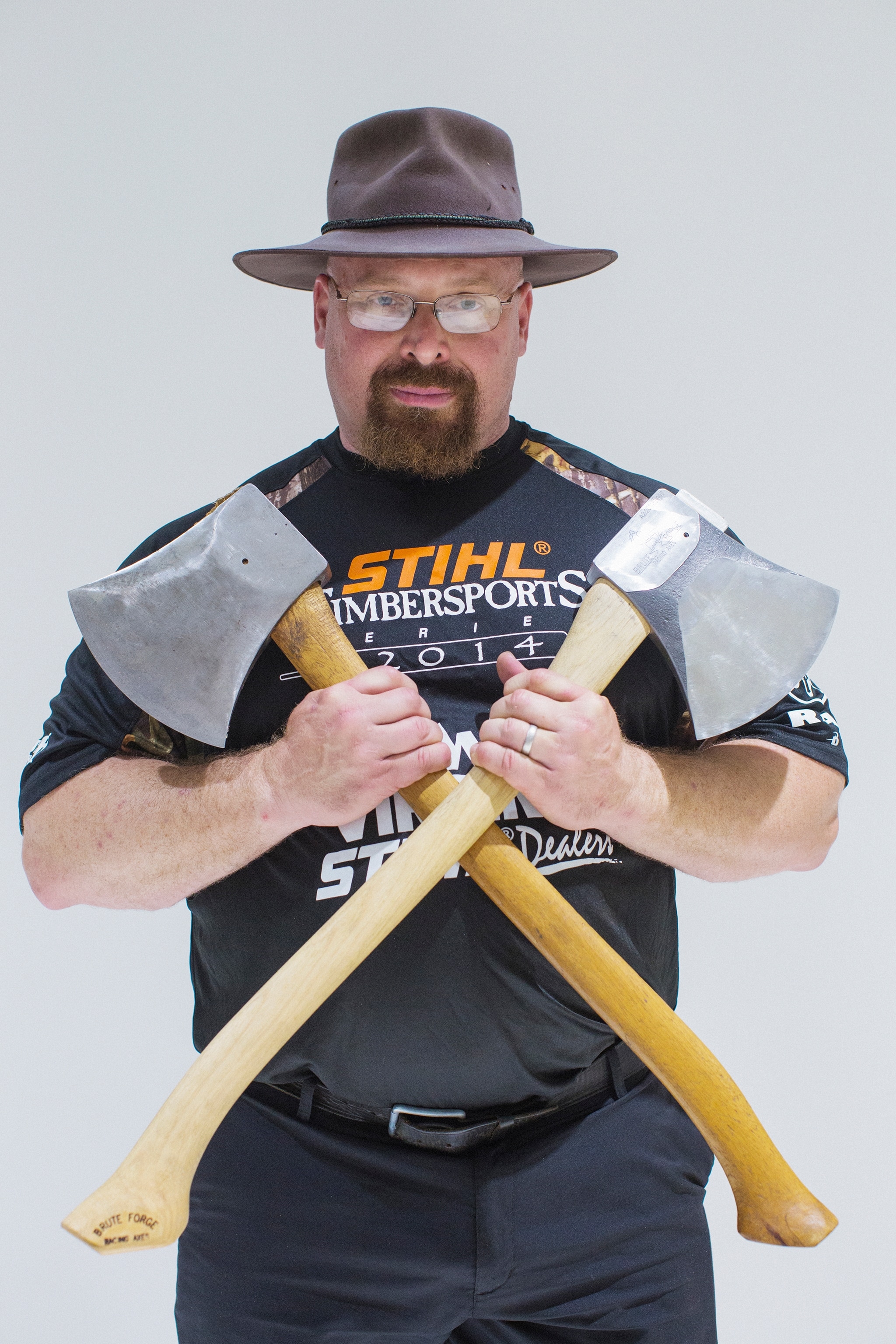
A Souped-Up Saw
The worst injury of the competition occurred during the fourth event, known as the single buck. It involves using a more than six-foot-long saw known as the "misery whip" for the toll it takes on the body. Lentz cut the side of his left hand on the back of his saw. He declined an offer for a bandage. He sat on a folding chair in the dressing room, glanced at his bleeding hand, then looked up to watch a television that was showing other lumberjacks competing. Lentz paid no attention to the blood that trickled down his fingers.
Arden Cogar managed to climb back into the competition and was closing in on his cousin Matt entering the final, loudest, and most crowd-pleasing event, the "hot saw." Like a funny car race, competitors use their own modified chain saws with single-cylinder motors typically ripped out of dirt bikes or snowmobiles to cut through 19 inches of pine.
"They have, pound for pound, the most horsepower of any motor in sports," Arden said of the lumberjacks' supercharged hot saws. The revving and the sirenlike sounds the hot saws emit, combined with the screams of a jolted audience, give the arena the feel of a NASCAR race.
Knowing he had to post a great time regardless of Matt's performance, Arden sawed too aggressively and cost himself a couple of seconds with less-than-clean cuts through the log. "I had to go for it," he explained. "I made a mistake."

By the end of the hot saw, Matt had secured the championship. Arden tied for second place; Lentz finished fifth.
Backstage, Dave Jewett of Pittsford, New York, the other second-place finisher, complained about a change in the competition rules that could have cost him $500 in prize money for having the best scores in the three sawing events. Moments later, an event staffer asked Jewett to do a television interview. He immediately declined, furious. Then he feigned enthusiasm and obliged. He punched a metal trash bin on his way out.
Lumberjack contests are short on material rewards. Even the winners usually make only a modest profit because the travel and equipment costs are so high. In Norfolk, Matt Cogar received $13,000 in various events and a new Dodge Ram pickup truck for winning the competition. He said he plans on trading in the truck for cash to cover his bills and help his wife with her student loans.
By 8:40 p.m., the arena was silent. All the fans and competitors had left except for Matt Cogar. In the dressing room, he used a paintbrush to delicately dust the wood chips out of the teeth of his single-buck saw.
When asked whether there was any glory in being the winning lumberjack, he stopped brushing, peered up with a smile, and said, "It's right here."



